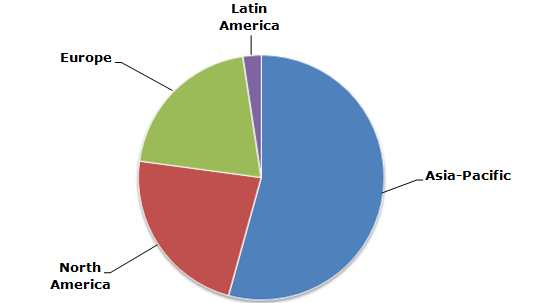Methyl methacrylate (MMA) is an important component in the production of multiple methylacrylate compounds applied in various industrial and consumer fields. The magnitude of MMA applications makes the forecast concerning its future behaviour on the market an almost futile task as the corresponding consumption markets are affected by a roster of factors and are extremely diversified, volatile and complex. Since MMA is heavily used in the form of polymer and copolymers in such enormous branches as construction, the automotive industry or electronics, its destiny will be inevitably connected to the macroeconomic conditions in these industries and in the world and national economies in general. Another layer of complexity lies in the necessity to take into consideration a specific regional, market-oriented or corporate aspect as many MMA-consuming fields do behave differently with respect to a certain location, market segment or even corporation.
As Asia-Pacific remains the major MMA region with respect to its actual output, consumption volumes or installed production capacity, the world MMA market scenarios will be largely predicated on the state of economy in this region.
Methyl methacrylate: structure of the world capacity broken down by region, 2013

The current economic slowdown in the Asia-Pacific region may act as a detrimental factor for the development of the MMA market in the short-term future. It should be also noted that geographical presence of MMA capacities does not fully coincide with actual ‘national’, or more precisely transnational or multinational, affiliation character of major MMA producers in the Asia-Pacific region. For instance, Mitsubishi Rayon Co Ltd. keeps nearly half of its MMA production capacity in the US and Europe, while a major Germany-headquartered MMA producer, Evonik Industries, operates world-scale MMA production facilities in China.
The current trend of relocating some of existing production capacities back to the USA or Europe may also influence the geographical spread in the MMA industry, though this trend might be fully viewed from specific corporate viewpoints as for many corporations China stands for continuous growth and it will therefore be an increasingly crucial driver for further capacity expansion.
Another vital dimension of MMA market behaviour includes macroeconomic conditions along the whole methacrylates value chain, including feedstock (and implemented production technologies), MMA itself, polymethyl methacrylate (PMMA), specialty monomers and thermoplastic methacrylate resins. The demand for MMA and its behaviour in each segment of this chain may be either invigorated or stampeded thanks to various reasons, including business and market environment, ecological norms and standards, future technological innovations, to name only a few.
More information on the methyl methacrylate (MMA) market can be found in the insightful research report “Methyl Methacrylate (MMA): 2015 World Market Outlook and Forecast up to 2019”.
